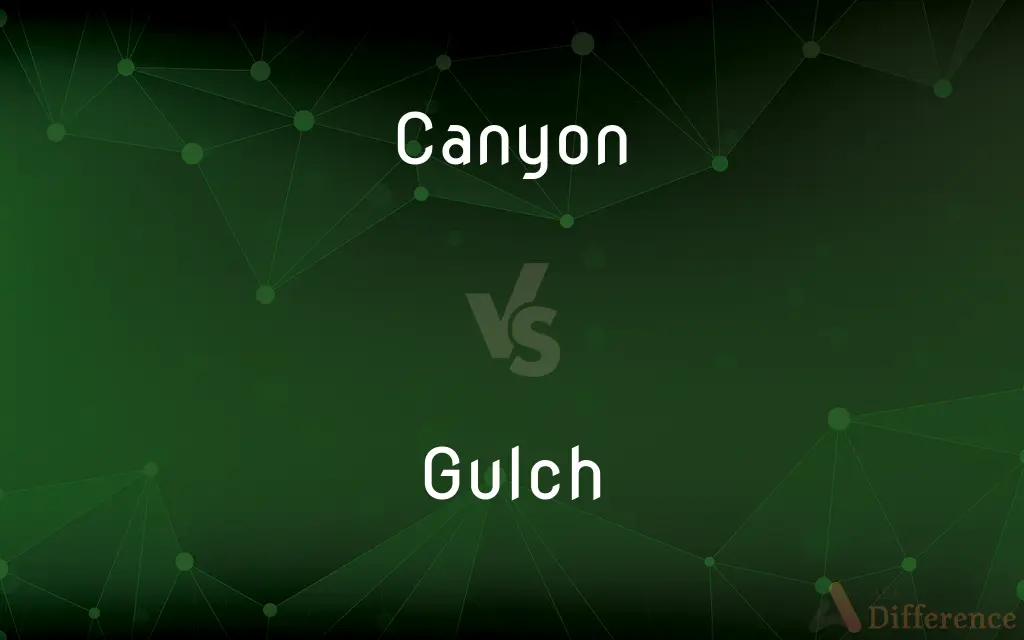Canyon vs. Gulch — What's the Difference?
By Tayyaba Rehman — Updated on October 12, 2023
Canyon is deep, narrow valley with steep sides, often with a river flowing through it. Gulch is narrow and steep-sided ravine marking the course of a fast stream.

Difference Between Canyon and Gulch
Table of Contents
ADVERTISEMENT
Key Differences
Canyon vs. Gulch in Paragraph 1: A canyon is commonly larger than a gulch, often found in arid regions, and typically carved by a river that has cut through rock, creating deep ravines with notably steep walls. In contrast, a gulch, while still a type of geographical formation with steep sides, tends to be smaller and is often the result of swift erosion from a rapid stream, which may not always be present, especially in dry seasons.
Canyon vs. Gulch in Paragraph 2: Canyons are typically characterized by their impressive size and are often destinations for tourism and recreation, while gulches might not be as widely recognized or visited due to their smaller size and possibly less dramatic appearance. A canyon might host a variety of recreational activities like hiking, river rafting, or sightseeing, whereas a gulch might be more isolated or less accessible for such purposes.
Canyon vs. Gulch in Paragraph 3: The term "canyon" comes from the Spanish word "cañón," which translates to "tube" or "pipe," conveying the idea of a long, hollow passage, whereas "gulch" derives from the word "gulshen," which is Middle English, suggesting a concept of gushing or flowing rapidly, alluding to the fast-moving waters that often create these features.
Canyon vs. Gulch in Paragraph 4: Geologically speaking, canyons and gulches both represent the erosive powers of water, but canyons, due to their larger size and scope, often expose a more extensive geological history through their stratified walls. Gulches might not offer such a broad display of sedimentary layers and might exhibit more localized geological traits due to their smaller size and different formation processes.
Canyon vs. Gulch in Paragraph 5: Biologically, canyons might host a wider array of ecosystems and biodiversity due to their larger and potentially varied environments. Gulches, though they might have unique and specialized biota, may not offer the same breadth of ecological diversity owing to their comparatively smaller and potentially more uniform environments.
ADVERTISEMENT
Comparison Chart
Size
Generally larger
Typically smaller
Tourism & Access
Often tourist attractions
Less visited
Origin of Word
Spanish ("cañón")
Middle English ("gulshen")
Geological Exposure
Extensive stratification
Might lack visible strata
Biodiversity
Possibly more diverse
Possibly less diverse
Compare with Definitions
Canyon
A canyon is a large, deep ravine with steep sides.
The Grand Canyon in Arizona is one of the most visited tourist spots in the USA.
Gulch
A gulch is a steep-sided, narrow ravine formed by erosion.
The gulch became noticeably deeper after the heavy rainfall.
Canyon
Canyons can serve as habitats for a wide variety of organisms.
The depth and size of a canyon can create unique ecosystems within its confines.
Gulch
Gulches might be associated with historical or wild-west themes.
In western movies, a deserted gulch often serves as a dramatic backdrop for showdowns.
Canyon
Canyons may be significant for outdoor recreational activities.
Many tourists explore the canyons for hiking, photography, and river-rafting adventures.
Gulch
Gulches are often found in mountainous regions and can be dry.
Explorers found an old mine hidden within a secluded gulch.
Canyon
A canyon can expose multiple geological strata on its walls.
Scientists study the walls of canyons to understand the Earth’s geological history.
Gulch
A gulch may lack the extensive biodiversity found in larger canyons.
The sparse vegetation in the gulch was primarily drought-resistant plants.
Canyon
Canyons often form in arid or semi-arid regions due to river erosion.
The Colorado River played a significant role in shaping the Grand Canyon.
Gulch
Gulches may be created by fast-moving streams or flash floods.
The gulch was carved over centuries by seasonal flash floods.
Canyon
A canyon (from Spanish: cañón; archaic British English spelling: cañon) or gorge is a deep cleft between escarpments or cliffs resulting from weathering and the erosive activity of a river over geologic time scales. Rivers have a natural tendency to cut through underlying surfaces, eventually wearing away rock layers as sediments are removed downstream.
Gulch
In xeric lands, a gulch is a deep V-shaped valley formed by erosion. It may contain a small stream or dry creek bed and is usually larger in size than a gully.
Canyon
A deep gorge, typically one with a river flowing through it, as found in North America
The Grand Canyon
Gulch
A narrow and steep-sided ravine marking the course of a fast stream.
Canyon
A narrow chasm with steep cliff walls, cut into the earth by running water; a gorge.
Gulch
A small ravine, especially one cut by a torrent.
Canyon
A valley, especially a long, narrow, steep valley, cut in rock by a river.
Gulch
(obsolete) To swallow greedily; to gulp down.
Canyon
The English form of the Spanish word Cañon.
Gulch
(obsolete) To fall heavily.
Canyon
A ravine formed by a river in an area with little rainfall
Gulch
A ravine-like or deep V-shaped valley, often eroded by flash floods; shallower than a canyon and deeper than a gully.
Gulch
(obsolete) An act of gulching or gulping.
Gulch
(obsolete) A glutton.
Gulch
Act of gulching or gulping.
Gulch
A glutton.
Gulch
A ravine, or part of the deep bed of a torrent when dry; a gully.
Gulch
To swallow greedily; to gulp down.
Gulch
A narrow gorge with a stream running through it
Common Curiosities
What primarily forms a canyon?
Erosive activity, often from a river, forms a canyon over a long period.
Are all canyons and gulches dry?
No, while some are dry, others might have rivers or streams running through them.
Are gulches found in specific geographical locations?
Gulches are commonly found in mountainous regions, often in the western USA.
Is a gulch always formed by a stream?
Not always, but they are often associated with fast-moving, erosive water sources.
Are there underwater canyons?
Yes, underwater canyons, like submarine canyons, exist on the ocean floor.
How are canyons and gulches useful to scientists?
They provide insights into geological and environmental history through their formations and ecosystems.
Can canyons be found worldwide?
Yes, canyons are found on every continent, exhibiting various sizes and forms.
Is a canyon always larger than a gulch?
Typically, yes. Canyons are generally larger and wider than gulches.
Do gulches and canyons have different types of vegetation?
Yes, due to their size and location, they might host different types and amounts of vegetation.
Is a gulch always associated with the wild west?
Often but not always. Gulches are geographical features, but they're iconic in wild west imagery.
Share Your Discovery

Previous Comparison
Fate vs. Coincidence
Next Comparison
Recombinant vs. NonrecombinantAuthor Spotlight
Written by
Tayyaba RehmanTayyaba Rehman is a distinguished writer, currently serving as a primary contributor to askdifference.com. As a researcher in semantics and etymology, Tayyaba's passion for the complexity of languages and their distinctions has found a perfect home on the platform. Tayyaba delves into the intricacies of language, distinguishing between commonly confused words and phrases, thereby providing clarity for readers worldwide.














































